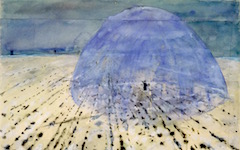Anselm Kiefer’s From Oscar Wilde (1974)

Anselm Kiefer, From Oscar Wilde (1974) Watercolor and gouache on paper. 39.7 x29.8 cm. Metropolitan Museum of Art, New York
Click image to enlarge.
How can we extract meaning from a simple watercolor of a rose titled From Oscar Wilde by Anselm Kiefer? It must have meaning because Kiefer believes that art should be difficult and challenging and make people scratch their heads.1 He is, besides, an outspoken practitioner of the Inner Tradition fascinated by alchemy, transformation and the search for self-knowledge. Shamanism, Kabbalah, myth and cosmology are some of his interests. It may nevertheless puzzle some that the connection between man and divinity "lies at the heart of Kiefer's oeuvre, despite the fact that he would not consider himself to be a religious man."2
Click next thumbnail to continue
Although Kiefer's awareness of a cosmic essence is well-known and he believes that through metamorphosis anything can be transformed into anything else, no critic has yet noticed that Kiefer has transformed his own face into the rose.3 This is not surprising given that the rose has long been a symbol of mystical transcendence as in the rose windows of Gothic cathedrals, rosaries and that little-understood strain of the Inner Tradition, Rosicrucianism.
Click next thumbnail to continue

Top: Detail of Kiefer's From Oscar Wilde, rotated 90° to the left
Bottom: Detail of Kiefer's The Orders of the Night (1996), rotated 90° to the left
Click image to enlarge.
Rotate the rose 90° to the left and his visage is visible. Black strokes denote his nostril and eye and red strokes his lips. Compared to a later self-portrait (bottom), the likeness is quite striking. Indeed a short curve and a dot have been used to mark his eye in both. Not coincidentally, perhaps, I also had to turn the self-portrait through the same 90° to make the comparison.
Click next thumbnail to continue
The self-portrait comes from his reclining figure near the lower edge of this large canvas, The Orders of the Night. There have been many others, no doubt, that would have looked similar.4 Here, it is as though giant sunflowers are growing from the artist's body because, as in the watercolor of the rose, Kiefer uses nature's constant growth and decay as metaphors for his (and our) own constant change.
Click next thumbnail to continue
More Works by Kiefer
Notes:
1. Kathleen Soriano, “Building, Dwelling, Thinking” in Anselm Kiefer (London: Royal Academy) 2014, p. 21
2. Soriano, p.24; For shamanism and cosmology, see Christian Weikop, “Forests of Myth, Forests of Memory” in Anselm Kiefer, op. cit., p.38
3. Weikop, p. 47; Richard Davey, “In the Beginning is the End and in the End is the Beginning” in Anselm Kiefer op. cit., p. 49
4. Kiefer's actual nose seen in photographs is not as pointed. Nevertheless, this figure is acknowledged in Kiefer's current exhibition at the Royal Academy to be "a self-portrait". As some readers of EPPH will know, it is not unusual for artists to change the shape of their nose in self-portraits as Van Gogh, for instance, constantly did. See the October 2010 post Van Gogh's Nose.
5. "The artist's sense of being at one with the world extends beyond the present, however, to encompass all time and space..." Davey, p. 50
Original Publication Date on EPPH: 27 Jan 2015. © Simon Abrahams. Articles on this site are the copyright of Simon Abrahams. To use copyrighted material in print or other media for purposes beyond 'fair use', you must obtain permission from the copyright owner. Websites may link to this page without permission (please do) but may not reproduce the material on their own site without crediting Simon Abrahams and EPPH.



